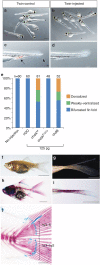The origin of the bifurcated axial skeletal system in the twin-tail goldfish
- PMID: 24569511
- PMCID: PMC3948052
- DOI: 10.1038/ncomms4360
The origin of the bifurcated axial skeletal system in the twin-tail goldfish
Abstract
Twin-tail goldfish possess a bifurcated caudal axial skeleton. The scarcity of this trait in nature suggests that a rare mutation, which drastically altered the mechanisms underlying axial skeleton formation, may have occurred during goldfish domestication. However, little is known about the molecular development of twin-tail goldfish. Here we show that the bifurcated caudal skeleton arises from a mutation in the chordin gene, which affects embryonic dorsal-ventral (DV) patterning. We demonstrate that formation of the bifurcated caudal axial skeleton requires a stop-codon mutation in one of two recently duplicated chordin genes; this mutation may have occurred within approximately 600 years of domestication. We also report that the ventral tissues of the twin-tail strain are enlarged, and form the embryonic bifurcated fin fold. However, unlike previously described chordin-deficient embryos, this is not accompanied by a reduction in anterior-dorsal neural tissues. These results provide insight into large-scale evolution arising from artificial selection.
Figures




References
-
- Janvier P. Early Vertebrates Clarendon Press: Oxford, (1996).
-
- Kardong K. V. Vertebrates: Comparative Anatomy, Function, Evolution 6th edn McGraw-Hill: New York, (2011).
-
- Lauder G. V. & Liem K. F. The evolution and interrelationships of the Actinopterygian Fishes. Vol. 150 (1983).
-
- Schultze H.-P. & Arratia G. The composition of the caudal skeleton of teleosts (Actinopterygil: Osteichthyes). Zool. J. Linn. Soc-Lond. 97, 189–231 (1989).
-
- Chen S. C. A history of the domestication and the factors of the varietal formation of the common goldfish, Carassius auratus. Sci. Sinica 6, 89–116 (1956).
Publication types
MeSH terms
Substances
Associated data
- Actions
- Actions
- Actions
- Actions
- Actions
- Actions
- Actions
LinkOut - more resources
Full Text Sources
Other Literature Sources

